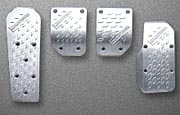Article Topics:
- Overview
- Intro to Racing
- Driving Technique
- Practice Sessions
- Driver’s Gear
- Vehicle Safety
- Handling
- Brakes
- Power
- Tools
TurnFast
recommends
these books:
Articles about Driving Techniques
Pedals
This section covers a few basics about the use, and the design and layout of the foot pedals, and prepares for the discussion of the heel-toe downshift.
How many pedals are there? Did you guess four? In a manual transmission car there should be four pedals:
- Accelerator (gas)
- Brake
- Clutch
- Rest (or "dead" pedal)
The rest pedal is a permanently positioned pedal pad at the far left to rest the left foot on. It provides a place to stabilize the leg when not using the clutch. In a street car without a racing seat or racing seat belts, the rest pedal is effective for bracing yourself around corners, but if you have a proper seat and belts, don't get into the habit of pushing hard against the rest pedal--relax and let the seat and belts do their job.
The first thing to get straight about using the pedals is that they are operated with the ball of the foot (the bony part just behind the toes), and not the toes. Secondly, you must be able to depress the pedals all the way with the ball of the foot while still having some bend in the knee. You cannot have the needed control and sensitivity in operating the pedals if the leg is completely outstretched. (See the Seating Position article for more positioning details).
Every pedal must be used smoothly. Stabbing at the accelerator or brake pedal in particular will cause sudden shifts in weight distribution on the car's suspension and will unsettle the car. Do this at the wrong time, and a loss of control is inevitable.
When applying either the brake or gas pedals, ease into it allowing a smooth transition to the full pressure needed. "Easing" does not necessarily imply being overly slow about it. A rapid but smooth and controlled transition is what is wanted. Avoid sudden jerky movements in either braking or accelerating.
One of the pedal control techniques used in racing is the heel-toe downshift. To maximize the speed and smoothness through a corner, it becomes necessary to do some cockpit acrobatics and operate the steering wheel, shifter, clutch, brake, and accelerator all at the same time. The problem is that there is five functions to perform and only four limbs to do it with. Something has to do double duty, and it turns out to be the right foot.
Refer to the Heel-Toe Downshift article for details of the technique itself, but the short of it is that prior to the entry of a corner, the right foot will need to operate the brake pedal and the accelerator at the same time.
Chances are the pedals in your street car are not going to allow you to properly do the heel-toe down shift as it will be too difficult to operate the brake and gas pedals at the same time, and you will need to have the pedals changed. After-market pedal kits are used to replace the stock rubber covers on the pedals. The clutch and brake pedals will be bigger to give you more sensory feedback. The gas pedal will be larger, but will also have an extension on the lower left corner allowing it to be more easily reached during the downshift. Some after market pedals intended for the fashion conscious will have simple bend tabs to hold them in place over the stock pedal pad. This has no place in a car used for racing. Be sure to get quality pedals designed to be bolted onto the steel pedal plate in place of the rubber pads.
Also, you may need to use shims to raise either the brake pedal or gas pedal to allow comfortable reach when operating both pedals. The brake and gas pedals should be close to the same height at the time you need to operate both simultaneously. When the brake pedal is fully depressed, it's height should be roughly equal to the height of the gas pedal when it is not pressed. This allows for more comfortable and controllable heel-toe maneuvers.
Read Next Article (Heel and Toe Downshift)
Tags: Race Pedals

These after-market pedals are typical of those needed on a manual transmission car to perform the heel-toe downshift. Note the extension on the gas pedal's left side. This makes it easier for the heel to reach the pedal while the ball of the foot operates the brake pedal. Note the mounting holes so they can be bolted to the car's pedal plates.
